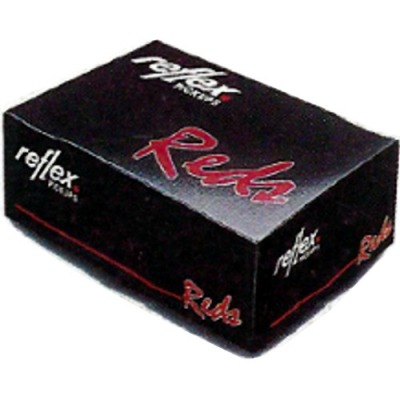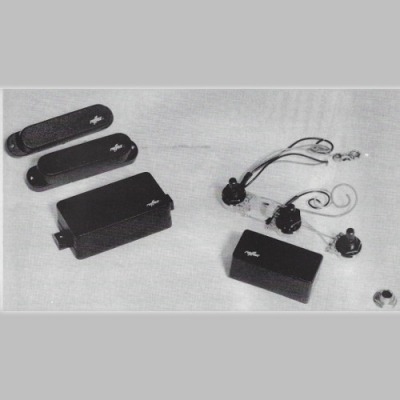Overview
Brand name:
Product:
- pickups
Dates of manufacture:
Reflex Reds pickups were introduced in 1988 - they were premium active pickups made in the UK. They were sold in sets (SSH or HH) along with a separate "black box" preamp essential to their correct operation.
Neville Marten reviewed Reflex Reds soon after their launch in the May 1988 issue of Guitarist magazine as follows:
We British are not exactly recognised for our guitar pickups! Although we do have some very good bobbin winders here - Kent Armstrong, of course, David White, UKG and so on, I doubt many of these rival the big American guns quantity wise although a Kent firm is looking to change all that...
Rhino Music Spares and have around spent the last three years and around £100,000, on what must be one of the most exhaustive research programmes into the whys and wherefores of guitar pickup design and manufacture. When undertaking this seemingly daunting task John Weatherley, Managing Director of Rhino, decided to approach it from a scientific, rather than what he terms the ‘black arts’ direction. So a team was assembled including electronics expert John Oram, whose background includes designing professional studio consoles for Trident Audio. However, well aware of the dangers of leaving rock and roll in the hands of the ‘Tefal men’ (no disrespect intended) John commissioned Geoff Whitehorn, that veteran rocker last seen on the Marshall stand at Frankfurt, and Keith Winter, guitarist from Shakatak to listen, assess and generally pass comment. The result is Reflex Reds, which come ready to fit, with all the necessary components including springs and screws.
Among the design team’s parameters were first and foremost a musical sound, very quiet operation, low pickup from mains and lights and, with the USA in mind, low susceptibility to radio frequencies. Another important consideration was battery conservation, and due to a fundamentally different design approach, Reflex can brag three times the battery life of, say, a set of EMGs.“So what’s this fundamentally different approach,” I hear you yawn? Well it goes something like this.
The usual way active systems operate is that each pickup contains its own electronics - preamp and all that — generally buried in epoxy resin. From there the signal goes to the volume and tone pots which are by their very nature interactive — turn the volume down and you lose tone, turn the tone down and you lose volume. So what Reflex have done is to lump the electronics of all the pickups into what they call the ‘black box’. Two advantages become immediately apparent — the pickups share a single set of guts (hence the extra battery life) and the volume and tone controls (Reflex like to call them Level and EQ) can be totally isolated from one another - tone is inserted in the chain before the black box and the volume after. It’s great to be able to reduce volume but maintain your exact tone settings or modify the tone whilst keeping the overall level just as it was. Another interesting aspect of this is that every position on the tone knob seems to do something!
But all that means nothing if the basic sound is rubbish. So how do they fare? I went down to Reflex to try out some of the first production sets — a standard Stratocaster layout and an ESP Tele with two humbuckers fitted. The Strat’s clean sounds were quite stunning — bags of headroom,clarity and sweetness. Dirtying things up a bit the guitar retained all the essence of a Strat, including the ability to use the pick to control dynamics to an impressive extent.
The Tele I wasn’t so fond of. The front pickup was great — warm and rounded, rather PAFish - but the back pickup seemed a bit clanky and unmusical to my ears. These rather brief tests were conducted in the Rhino offices through an amp which was not too familiar, so I brought the two guitars back and gave them a good blasting in our professional demonstration studio (the garage). This time I used a new Fender Twin as the test bed and the humbucker behaved rather differently. (I say humbucker when in fact all these pickups are truly humbucking - it’s just my way of differentiating them style wise). The Twin has an inordinate amount of gain on the lead channel, and this time using the ESP the tone and sustain were incredible — it wouldn’t let go! I must say though that I quite like using relatively weak pickups and notching the amp up that much further - for instance I prefer ‘standard’. EMGs without the mid boost, and Seymour Duncan’s Alnico Pro IIs to his Strat Stacks - but then I’m funny that way! With the Reflex bridge humbucker though it was tone, rather than volume, which had seemed lacking.
Curiously (or not so curiously if you think about it) Mr Whitehorn had come to very similar conclusions to mine regarding this particular pickup and persuaded Reflex to inject a considerable amount more balls, if you’ll excuse the term. This was the set Geoff was brandishing in Frankfurt and the difference was amazing. All the harmonics, tone, volume and expression you could imagine were there, and this time it sounded good,clean as well as dirty.
From a manufacturing point of view the separate black box idea represents something of a coup.All the guitar’s tonal characteristics - volume, distortion, harmonic structure etc — can be tailored from the black box while the pickups remain standard. A fairly cruddy analogy might be that of a BMW car, where the bodyshells are identical across a particular range but each has a different engine under the bonnet.
There has been lot of excitement generated by these pickups and quite rightly so. T’Pau are using them, Saxon have a set or two, and Valley Arts Guitar in California are showing them around to guys like Lukather and Carlton, etc. But more importantly they are now available to the likes of you and me. It seems probable that Reflex are going to use both the standard and the Whitehornised humbucker as options on their SSH (Strat, Strat, Humbucker) and HH (Humbucker, Humbucker) sets. The range already incorporates most standard guitar and bass configurations and other inclusions are likely to come soon. I hope that Reflex dealers will kit out some guitars with these pickups (a second-hand Squier Strat and Jazz Bass would do) so that we punters can actually sit down and compare them with what else is available. From what I’ve seen and heard, comparisons should be very favourable . . .
RRP; SSH £169.95 (inc. VAT)
HH £129.95 (inc. VAT)For more information please contact Reflex Guitar Systems Ltd., Unit A4 and A5, Springhead Enterprise Park, Northfleet, Kent, DAII 8HB. Tel.no; 0474 320285.
Specifications
Prices (3)
| Date | Price | Condition | Name | Comments |
|---|---|---|---|---|
| 1988 | £169.95 | new | guitar-list | RRP for the SSH set |
| 1988 | £129.95 | new | guitar-list | RRP for the HH set |
| 1988 | £129.95 | new | guitar-list | RRP for the HH set |

